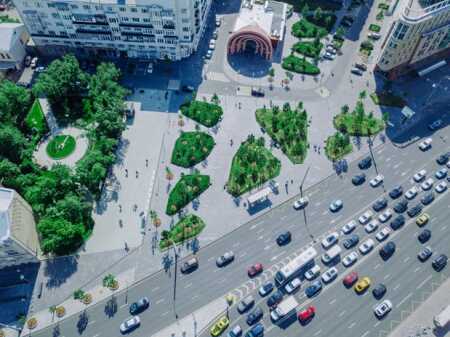Type: Program/initiative
Uses: Office, retail, restaurant, entertainment, hotel, residential, civic, education, parks/open space, surface parking
Developer: Department of Overhaul of the City of Moscow
Designer: Strelka KB; Djao-Rakitine; Snøhetta; West 8; Topotek 1; Martha Schwartz Partners, OKRA; Karres + Brands
Size: 817.9 acres (331 ha)
Date started: 2015
Date opened: 2017
Land uses:
Street/parking: 57.6 miles (92.8 km) of street reconstructed
The Moscow Street Program reimagined more than 200 public spaces across Moscow between 2015 and 2017, ahead of the 2018 FIFA Men’s World Cup. The program, led by Strelka KB, the architecture consultancy branch of Moscow’s Strelka Institute, may be the largest infrastructure project in Russia since the Soviet era.
The program transformed empty space, parking, and wide roads into safer, more walkable places by redesigning streets and public spaces to be pedestrian oriented. As a result, pedestrian traffic in the center city has increased by 23 percent, while traffic collisions resulting in injury have decreased by 56 percent, all while traffic moves about 30 percent faster.
As part of the program, Strelka KB put together architecture competitions focusing first on young Russian talent before opening it up to international entries. The redesigns reflected Moscow’s rich history. For example, construction uncovered a fragment of the 16th-century White City Wall leading to the creation of a new outdoor amphitheater around the wall rather than the parking garage that was planned for the site. Likewise, the program restored historic infrastructure details such as bridge supports, light poles, and manhole covers.
To determine what kind of space was needed and how it would be used, the program enlisted urban and digital anthropologists, including the voices of residents, in the design of their community. During the transformation, more than 7,000 trees were planted, creating new green space that Moscow sorely lacked.
Strelka KB joined forces with DOM.RF, an integrated housing development institution, and the Russian Ministry of Construction to compile Moscow Street’s best practices into the Future Cities program, leading to the transformation of at least 223 public spaces in 40 cities across Russia.
This article is one of 11 highlighting this year’s winners of the ULI Global Awards for Excellence.






